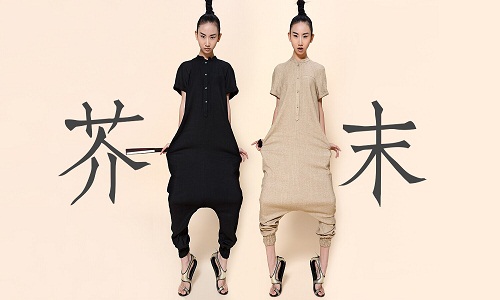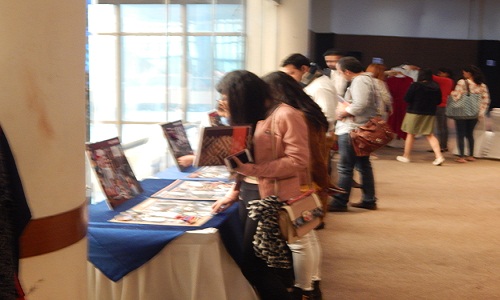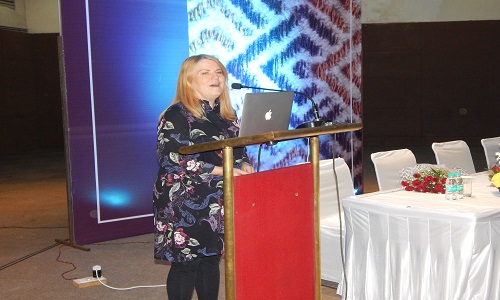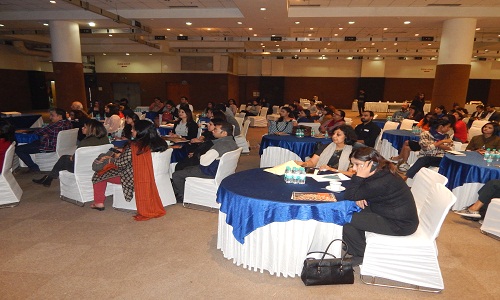FW
Fashion designers and movie stars have decided to bat against violence against girls and women as a part of a new social campaign for the fashion conglomerate Kering. The campaign called ‘White Ribbon For Women', it features Hollywood actresses Salma Hayek Pinault, alongside Gucci's Alessandro Michele, Stella McCartney, Christopher Kane, Joseph Altuzarra and Dennis Chan. The star-studded cast is raising awareness about violence against women through the hashtag #ICouldHaveBeen and its complementary website ICouldHaveBeen.org.
The website asks men to imagine who they could have been had they been born female and asks women to imagine being ‘her', highlighting the fact that globally, one in three women/girls is the victim of violence. Michele, Kane, Altuzarra and Chan have each revealed the names their parents would have given them had they been girls, while McCartney and Hayek Pinault take on the moniker ‘Her', inviting social media users, particularly from Generation Z and Y, to do the same before sharing their photos across Instagram, Facebook, Twitter, LinkedIn and WeChat.
François-Henri Pinault, Chairman & CEO of Kering, and Chairman of the Kering Foundation said, "Being born a girl should not equate to a higher risk of violence yet, unfortunately, it is the case in our world today. We all could have been born a girl, we all must take on this combat. A combat I am proud to confront together with the Kering Foundation, our Houses and their designers via our sixth annual White Ribbon For Women campaign."
This is the sixth time that Kering has run the ‘White Ribbon for Women' campaign but the luxury brand isn't the only fashion conglomerate to have taken on a cause. In August, French giant Dior teamed up with the WE Charity to support its educational initiative through a new social media campaign called the ‘Dior Love Chain’, recruiting a range of stars, including Natalie Portman, Rihanna, Robert Pattinson, Jennifer Lawrence and Charlize Theron to spread the message by revealing what they would do for love. For each post hashtagged #DiorLoveChain posted to social media, Parfums Christian Dior pledged to donate $1 to support the WE Schools initiative to provide education for young girls in Kenya up to $2,50,000. The campaign runs through December 31, 2017.
The Northern India Institute of Fashion Technology (NIIFT) has teamed up with Groz-Beckert Asia, NIIFT to train underprivileged in industrial sewing machine course. NIIFT is is giving space for training facility while Groz-Beckert Asia has offered machinery, equipment, furniture and other related installations including IT peripherals. It has set up a skill development and training facility for the underprivileged students which will be used in a free course of the Industrial Sewing Machine Operator.
Moreover, for the smooth functioning of the training facility Groz-Beckert Asia will provide essential financial support. Once the training is over, every pass-out will become employable in the apparel and textile industry. The facility will also help them in finding suitable jobs. The content of the training course has been designed looking at the current and future needs of the industry.
The facility was inaugurated by Anton Reinfelder, Managing Director, Groz-Beckert Asia and Inderjit Singh, Registrar, (NIIFT) in the Ludhiana campus of NIIFT.
"Los Angeles, home to denim labels lie True Religion, Lucky Brand, Hudson and 7 For All Mankind, was once a Mecca for jeans makers in the US. But recent rise in California and Los Angeles’ minimum wage, a move by blue-jeans owners to strengthen profit margins, is having a devastating impact on Los Angeles denim factories. Earlier this month, United Denim informed state employment officials that it planned to lay off 164 of its approximately 200 employees by the end of the year. As per experts, by 2021, the minimum wage will be at $15 an hour."

Los Angeles, home to denim labels lie True Religion, Lucky Brand, Hudson and 7 For All Mankind, was once a Mecca for jeans makers in the US. But recent rise in California and Los Angeles’ minimum wage, a move by blue-jeans owners to strengthen profit margins, is having a devastating impact on Los Angeles denim factories. Earlier this month, United Denim informed state employment officials that it planned to lay off 164 of its approximately 200 employees by the end of the year. As per experts, by 2021, the minimum wage will be at $15 an hour.

Mateo Juarez, owner, United Demin Inc, opines if you make blue jeans in China, including the fabric washes, it is $6. If you do the same jeans in Mexico, you can make it for $10, which includes dropping if off in Los Angeles. And if you do it in the US, you are looking at $40 to $50. That’s a big difference. If 100,000 jeans are manufactured in Mexico, it will cost $1 million. Make those jeans in Los Angeles, the price skyrockets to $4 million. The difference is astronomical and only economically practical if blue jeans are selling for $100 to $200. These days, new leaders in the executive offices are less concerned about that ‘Made in USA’ label and more concerned about return on investments. They are reducing costs by heading to Mexico, Vietnam and India, where labour costs and regulations aren’t as stiff as they are in the US. Ilse Metchek, President, California Fashion Association feels almost all denim in LA is going out the door. It’s because of minimum wage as denim is very labour-intensive.
Finding alternatives
Around five years ago, Atomic Denim employed 1,000 workers in its two Los Angeles factories making blue jeans for True Religion. Today, there is only one factory with 70 to 100 workers who fluctuate with season in their production for Hudson, Tom Ford and Diesel. Last year, to meet lower price demand, Atomic Denim opened a Tijuana, Mexico, factory where the salary for 70 workers is about half of what they are in Los Angeles. Claudia Bae Kye, VP, E&C Fashion, the parent company of Atomic Denim and Pacific Concept Laundry, said large volumes are missing in Los Angeles unlike before. The market is different.
Similarly, three months ago, Steve Rhee took over the 100,000 sq. ft. factory with 600 sewing machines from his parents. Now called Factory One Studio, Rhee has only 75 workers that where he used to employ hundreds earlier. The factory’s biggest clients used to be True Religion and Lucky Brand. One year ago, the factory was rolling out nearly 3,000 pairs of blue jeans a day. Now, the company is making about 1,500 pairs of blue jeans for Diesel, J Brand and Fear of God. Many companies are only interested in making 100 to 200 units at a time. These days, every company is shifting to Mexico. It is hard to find consistent work in Los Angeles.
Last year, True Religion’s business shrunk and blue jeans made up only 20 per cent of production for labels such as Current/Elliott, Joie, Kate Spade and Theory. About 80 per cent of production became army uniforms and the rest was denim. The employee workforce dropped to 100. Also, military-uniform makers only wanted to pay the federal minimum wage of $7.25 an hour rather than the higher Los Angeles minimum wage. All these together are forcing companies to move away from LA and find another suitable haven.
The Mexican Ministry of Economy has issued a new standard for clothing care labels and symbols – NMX-A-3758-INNTEX-2014 “Textile – Code of Generation of Caring Labels with the Use of Symbols”. The new standard is identical to the international standard ISO 3758:2012 “Textile – Care Labeling Code Using Symbols”. The new standard uses five basic care symbols for wet and dry cleaning but excludes industrial laundry techniques. The symbols are ordered washing, bleaching, drying, ironing and professional textile care.
This standard set out the most severe treatments that can be used on an item of clothing without causing irreversible damage. In Mexico, textile and garment labels must comply with the correct standards (NOMs) and/or voluntary standards (NMXs).
If the relevant NOM specifies a NMX, this becomes mandatory. In general, all apparel, accessories, textile products and home textiles with over 50 per cent textile content must comply with the Official Mexican Standard NOM-004-SCFI-2006 for mandatory labelling requirements.
Mexican labelling standards normally require one or more permanent and legible label to be attached to the collar, waist or other visible location. They must show: Commercial brand name; Fibre composition a NMX-A-2076-INNTEX-2013 and NMX-A-6938-INNTEX-2013; Size; Care and preservation instructions must be indicated using brief and clear legends or the symbols indicated in the NMX-A-3758-INNTEX-2014, or both. Symbols different from those stipulated in the aforementioned standard may be used, only if the legend relating to proper treatment and the care and preservation instructions also appears in Spanish; Country of origin; Name and address of the manufacturer/importer with a voluntary mention of the RFC (federal taxpayers register) number.
Kenya’s garment sector export processing zones (EPZs) has recorded significant growth in recent years and boosted the country’s economy. This comes as good news because the fall in export was due to mismanagement and stiff competition from cheaper imports. Their EPZs saw growth in most of their performance indicators in 2016, revealed the Economic Survey. Total capital investment of enterprises increased from Sh48.1 billion in 2015 to Sh51.2 billion in 2016; the number of local staff working in the EPZ increased by 3.4 per cent to 52,019 in value terms’ exports increased 3.7 per cent to Sh63.1 billion in 2016.
The extension of the African Growth and Opportunity Act (AGOA) initiative up till September 2025 has kick started the growth trajectory in textile sector. Though AGOA originally covered eight-year period from October 2000 to September 2008, amendments by then US President George Bush in July 2004 extended it to 2015. The US Congress then extended it further to 2025.
Several Kenyan products, notably apparel and agricultural produce have benefitted from this arrangement which has enhanced import duty on all eligible products and granted preferential market access post compliance with Rules of Origin.
The resurgence of the Kenyan textile has attracted new foreign investments. Several top global fashion brands including Calvin Klein, Arrow, Izod and Cherokee have recently signed production contracts with local textile manufacturers in the country.
The government has launched subsidy schemes to provide financial assistance of up to 90 per cent under the Pradhan Mantri Credit Scheme for powerloom weavers. Under this scheme, the government will provide margin money subsidy of up to 20 per cent of the project cost with a ceiling of Rs 1,00,000 and interest subvention at six per cent per annum for working capital and term loan up to Rs 10,00,000 for a maximum period of five years.
The government has also introduced technology up gradation scheme, Sustainable and Accelerated Adoption of efficient Textile technologies to Help small Industries (SAATHI), to help the country’s ailing powerloom segment.
Ujwal Lahoti, Chairman, Cotton Textiles Export Promotion Council (Texprocil) explains, “This initiative is expected to benefit almost 2.5 million powerloom units, which produce 57 per cent of the total cloth in the country, across India. The use of efficient equipment would result in energy savings and cost savings to the unit owner who would in turn repay in instalments to EESL (Energy Efficient Services Limited) over a three- to four-year period.”
These schemes enable powerloom units to upgrade their technology and install solar power generation equipment to cut energy costs. After repayment of bank loans in around four years, the cost of electricity for power loom units will be zero, say experts. “The Union Textile Ministry and State Governments have announced several promotional schemes for power loom textile industry, but there is hardly any awareness of the schemes in the industry. The maximum benefit of these schemes has been taken by the entrepreneurs of Gujarat and Tamil Nadu” said Kavita Gupta, Textile Commissioner while speaking on the occasion of the buyer-seller meet in Mumbai. Of the 2.5 million powerlooms, 50 per cent are in Maharashtra. There are 108 power loom clusters in the country and 72 textile parks.
The VDMA Textile Machinery Association has accomplished successful events for the textile industries in the US and Mexico. Over 80 decision-makers from the US textile, nonwoven and carpet industry and 25 leading textile machinery and accessories manufacturers participated in the VDMA textile machinery conference held this month in Charlotte (NC). The two-day event in November in Mexico City attracted nearly 450 customers and 30 textile machinery and accessories manufacturers, making it one of the most successful events of the VDMA Textile Machinery Association ever.
The conference in Mexico City was addressed by José Cohen Sitton, President, National Chamber of the Textile Industry CANAINTEX, who said German textile machinery and engineering are one of the best in the world and added that the Mexican textile industry has to invest to be on top of technology no matter what the outcome of the on-going NAFTA negotiations are.
These two events focused on customers, training session at the Instituto Politécnico Nacional (Escuela Superior de Ingeniería Textil) in Mexico City held in November aimed at future engineers. About 500 textile engineering students followed the technical presentations from 18 textile machinery and components manufacturers. In the US and Mexico, VDMA member companies presented latest production technologies from spinning to dyeing and finishing. Major topics addressed were digitalisation of the textile and textile machinery industry, higher efficiency and profitability, energy, water and material savings, new applications with growth potential such as composites and nonwovens, higher quality with measurement, control and testing devices, technical training centres.
In 2018, the VDMA Textile Machinery Association will be supporting sales and marketing of member companies through trade fairs (German pavilions), own technical conferences and B2B as well as official trade missions in the following countries: Indonesia, India, USA, Belarus, Brazil, Uzbekistan, Iran, China, Egypt.
At a time when international trade is set to grow exponentially, the decline in India's export is disquieting and structural changes in labour-intensive sectors such as apparels and jewellery need to be immediately undertaken, Crisil says.
"Global merchandise trade is expected to grow stronger at 4.2 per cent, boosting trade intensity of growth for the first time in six years i.e. world trade growth being higher than world’s GDP growth. Yet, India's exports have not been able to take as much advantage of the stronger trade growth unlike many of its Asian peers like Vietnam, South Korea and Indonesia," said a note released by the rating agency.
The International Monetary Fund (IMF) also forecasts international growth in trade to rise to 3.6 per cent in 2017 from 3.2 per cent in 2016. However, the Federation of Indian Exports Organisations has noted almost Rs 50,000 crore worth of refunds under the Goods and Services Tax regime are still stuck with the Government, leading to a huge blockage of capital.
Exporters have also decried only around Rs 350 crore of refunds on account of integrated GST (IGST) have been released by the Government for July, against Rs 750 crore claimed by exporters. Furthet, the input tax credits are yet to be released. Responding to growing opposition by exporters, the government last week announced greater export support to items in the garment and the home furnishings sector under the Merchandise Exports from India (MEIS) and the Remission of State Levies.
"The enhancement in MEIS rates will help in the fulfilment of orders for the Christmas festival as it will result in easing blocked capital. It will help in the mitigation of the currency difference to some extent. However the Industry is disappointed over the announcement of the RoSL rate as it is far below what the industry has recommended and there has been no consideration of the central taxes rebate in the announcement. The industry is witnessing a slowdown with jobs being lost and buyers migrating due to high cost." Asho K G Rajani, Chairman of the Apparel Export Promotion Council said.
However, Crisil has pointed out that subdued export performance in recent months cannot be attributed to unfavourable currency competitiveness. In fact, a relatively stable rupee and enhanced international growth suggest that local developments such as GST might have had a greater role to play in the current export growth slowdown.
The Apparel Export Promotion Council (AEPC) under its awareness initiatives program kick-started the first series of Fashion Forecasting Seminars for the financial year 2017-18 in Gurgaon, recently.
The seminars are being organized by AEPC in association with WGSN, the world leading trend forecasting agency. The speaker at the event was Ms. Kim Mannino, Head of WGSN LIVE from WGSN, London office. Kim is very seasoned and experienced professional and has worked for over 30 years in the industry. She has worked with Promostyle for over 20 years and is currently leading the live presentations division of the company. At the presentation, Kim provided insights on Key Commercial Items, colours and trends for AW 18/19 and Textile Trends for SS 19. The AW 18/19 season was divided into 4 broad themes: Thinker, HumaNature, Dark Wonder and Worldhood.
The ‘Thinker’ explored an emerging era of enlightenment where ideas and education were the prized currency. For women’s wear, the focus was on simple, functional designs. The look was preppy, at times awkward and retro, harking back to the rebellious intellectualism of the Beatniks. Comfort dressing was also key, as the boundaries between work and leisure dissolve.
In an era driven by data, ‘HumaNature’ explores the urge to trust our instincts. Natural materials, tactile surfaces and quilted and intricately decorated designs gained prominence. Textiles look at global influences and time-honoured techniques, and layered blankets and salvaged fabrics create pieces that feel both old and new.
Dark Wonder explored the influence of new technologies on fashion. Augmented reality is opening the door to acceptance of more unusual aesthetics and in a world where we can create our own identities, gender fluidity and individuality are embraced. This is a trend that draws on themes of science fiction, escapism and experimentation with the human form.
WGSN's ‘Worldhood’ trend explores an increasingly globalised street culture where influences from around the world are shared and remixed faster than ever. The direction is youthful, expressive and nostalgic. Vibrant colours and clashing patterns are woven together to make familiar looks fresh again and classic items are reimagined in luxury fabrics.
All the above trends were brought to life by 3D ‘moodboards’ developed by WGSN and key commercial items of the season which were developed in-house by WGSNs clients in India.
"More than 1,200 national and international fashion brands will be present at Asia’s largest and most influential fashion fair, Chic Shanghai, from March 14 to 16, 2018. Spread over 100,000 sq. mt. of exhibition space in the world’s largest exhibition center, the National Exhibition & Convention Center, Shanghai. China’s economy is back on track after seven years with 6.9 per cent growth in 2017; Chinese consumers are optimistic about the future, with more millionaires in China in 2018 than in any other country, says a recent McKinsey study. By 2025, their share is expected to account for 44 per cent of purchases in the global luxury market, which is equivalent to around €131 billion. "

More than 1,200 national and international fashion brands will be present at Asia’s largest and most influential fashion fair, Chic Shanghai, from March 14 to 16, 2018. Spread over 100,000 sq. mt. of exhibition space in the world’s largest exhibition center, the National Exhibition & Convention Center, Shanghai. China’s economy is back on track after seven years with 6.9 per cent growth in 2017; Chinese consumers are optimistic about the future, with more millionaires in China in 2018 than in any other country, says a recent McKinsey study. By 2025, their share is expected to account for 44 per cent of purchases in the global luxury market, which is equivalent to around €131 billion. In general, willingness to spend money has returned, which is also noticeable among middle to upper income groups. Quality is more important than quantity.

Expenditure on the ‘key desires’ in China is rising, and the supply of these goods is to be increased. However, sustainability and health have become a key issue for consumers. The desire for individual offers and collections will be taken into account by Chic: the area of young design is extended and renewed; the retail sector, which focusses on lifestyle concepts and exclusive and creative brands, the multi-brand stores and boutiques have been targeted and have become co-operation partners of Chic.
Chic segments
The entire North Entrance Hall of the fair is dedicated to fashion design. Impulses is fully booked and will occupy the entire area. Renowned Chinese designers such as MU by Frank, Hua Mu Shen and Tuffcan will show latest collections. Likewise Wang Yutao, former Elle style ambassador and winner of China’s most important fashion award Jin Ding, and Shi Jie with his Shi Jie & Janique collection who exhibits internationally at designer forums in Paris. The Impulses area has been redesigned to provide the fashion clientele with a vibrant, creative fashion ambience. In the menswear Urban View, Shandong Ruyi, one of the largest fashion companies in China, is represented at Chic with the Saint Angelo line, as is the Semir Group with its brand Gson. Bespoke brands like Dalian Longsheng or Haisibao from Shandong also exhibit here.
Country pavilions
In the international Fashion Journey segment, 248 exhibitors from 14 nations use Chic as a presentation and service platform for their entry into the Chinese consumer market or the expansion of their business fields. The largest participation is traditionally from Italy, in March 40 brands in cooperation with Sistema Moda Italiana and Assocalzaturifici and the Italian Trade Agency ITA, which supports the participation with accompanying promotional measures. “We are putting a lot of energy into preparing this latest rendezvous with La Moda Italiana@Chic so as to build up an offering of brands and companies characterised by the selection and quality of their products in order to offer as complete as possible a panorama of the style expressed by Italian fashion. In addition, thanks to the contribution of Agenzia ICE, we will be realising an even more strategic presentation of the Italian area: at the centre of the exhibition route and in the heart of the international pavilion, featuring an elegant and functional layout to provide a united and coherent image of the Italian lifestyle,” said Alberto Scaccioni, CEO, EnteModa Italia.
Diversity distinguishes French fashion brands, which are gathered in the pavilion Paris Forever with clothing, accessories, shoes and bags, including brands like Georgio & Mario, Urbahia, Lener Cordier, etc. German companies present themselves under the umbrella of Made In Germany as part of the foreign trade fair program of the Federal Ministry for Economic Affairs and Energy, conducted by Messe Düsseldorf. The Polish Investment and Trade Agency is for the first time with a country presentation to promote ‘Fashion from Poland’ in China and uses Chic’s widespread network inside the Chinese trade. South Korea, China Hong Kong, China Taiwan, and Peru are represented with their own group holdings. Individual exhibitors come from Brazil, Denmark, France, China Hong Kong, India, Japan, Korea, Sweden, and the UK.
Enhanced service measures
Chic would place a special focus on visitor marketing. In the run-up to the trade fair, match-makings will be carried out especially focussed on overseas exhibitors, and a selected clientele of almost 50,000 contacts will receive detailed information about the international brands at Chic; the Chic App enables visitors to find out about the offer at the fair in a targeted manner; the Chic homepage offers visitors the opportunity to arrange appointments with the manufacturers at the trade fair. The traditional overseas exhibitors’ dinner will give further insights into the market with agents of international brands that are established in China sharing their experience.


















